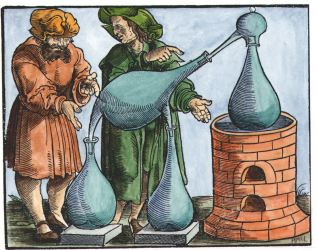| Author | Post |
|---|
Bernie Rowen
Member
| Joined: | Fri Jul 1st, 2011 |
| Location: | |
| Posts: | 3 |
| Status: |
Offline
|
|
Posted: Fri Jul 1st, 2011 02:54 pm |
|
Hello all,
I am writing a Dissertation on: Does the alchemical imagery of the early modern period present conventional astrology, or is it hinting at a deeper understanding of astrological significators as internal spiritual/psychological processes? for my Masters degree.
The question I have today is: Do any of you learned people have images from the years 500-1400 that I could write about? I need to present and essay soon.
Another question I will be in Frankfurt next week and would like to know if there are any worth while collections in Frankfurt that any-one knows about.
Thanks in advance, I am sure that I will chat with many of you over the next few months.
Best wishes
Bernie Rowen
|
adammclean
Member

| Joined: | Fri Sep 14th, 2007 |
| Location: | United Kingdom |
| Posts: | 606 |
| Status: |
Offline
|
|
Posted: Sun Jul 3rd, 2011 07:43 pm |
|
Bernie Rowen wrote:
The question I have today is: Do any of you learned people have images from the years 500-1400 that I could write about?
The earliest emblematic alchemical images are found in the
Buch der heiligen Dreifaltigkeit manuscript of around 1412. See Obrist Les Debuts del'Imagerie Alchimique (XIV-XV siecles). Another early illustrated alchemical manuscript from perhaps a few years earlier is the Gratheus.
Regarding the period 500-1400, there is very little emblematic imagery. Most of what does exist is religious. What does exist is in the form of drawings and illuminations in manuscripts. Woodcuts and engravings postdate 1400. Many manuscripts survive from around the 11th century onwards with wonderful imagery, but this is primarily religious and definitely not alchemical.
There is a mass of material from the early modern period so I am not sure why you want to explore pre-1400.
|
Bernie Rowen
Member
| Joined: | Fri Jul 1st, 2011 |
| Location: | |
| Posts: | 3 |
| Status: |
Offline
|
|
Posted: Sun Jul 3rd, 2011 07:56 pm |
|
Thanks for your reply Adam, yes in doing further research I found that it would be almost impossible to write about something that does not exist, so I am writing this essay on medieval art and its relationship to cosmology.
But.....my Dissertation is topic is: Does the alchemical imagery of the early modern period present conventional astrology, or is it hinting at a deeper understanding of astrological significators as internal spiritual/psychological processes?
So I will be working on that over the next 2 years  . .
By the way, are there any interesting collections in Frankfurt to have a look at that you know of?
Kind regards
Bernie
|
adammclean
Member

| Joined: | Fri Sep 14th, 2007 |
| Location: | United Kingdom |
| Posts: | 606 |
| Status: |
Offline
|
|
Posted: Sun Jul 3rd, 2011 08:40 pm |
|
Bernie Rowen wrote:
... is it hinting at a deeper understanding of astrological significators as internal spiritual/psychological processes?
This seems a rather rather modern idea - a late twentieth century esoteric/Jungian perspective.
During the early modern period, people did not really have such a way of looking at things. Instead they believed in the key ideas of astrology. They looked for the signature of astrology in the world about them, in substances, plants, even parts of the human body. Astrology beliefs drove many aspects of medicine. Most alchemists accepted the importance of astrology, just as they accepted the importance of Christian ideas. They looked for this in their work, wrote about it in their books, and incorporated aspects into the emblems they uses to illustrate their books and manuscripts. Astrology was just a component of the early modern mindset. After all, Astronomia was one of the Seven Liberal Arts.
To look for internal spiritual/psychological processes in the writings or imagery of this period is likely to be a flawed perspective, as it is very difficult for people in our times adopting such a view to free themselves from merely reading that view into this past material.
One of the most amusing of these is Hexastichon images from around 1500 sometimes ascribed to Sebastian Brandt, which Jung illustrated in his Mysterium Coniunctionis alongside some images from alchemical manuscripts including the Solidonius series. Now, the Hexastichon is thought of by some modern commentators as weird surreal alchemical images. The reality is that these pictures, far from being surreal, were in fact a mnemonic device, a simple memory system for remembering the key components of each of the four Gospels. It is easy to read present day ideas into the past. Anyone taking the time to read the short text of the Hexastichon which accompanies the woodcut images would realise this after a few minutes.
|
Bernie Rowen
Member
| Joined: | Fri Jul 1st, 2011 |
| Location: | |
| Posts: | 3 |
| Status: |
Offline
|
|
Posted: Sun Jul 3rd, 2011 08:52 pm |
|
Yes Adam, and that is why the question is in fact a question...it is one that I could argue effectively once reading all the material that maybe the Good Psychiatrist [Jung] was not correct in his use of 'Psychological Alchemy'...or for that matter Psychological astrology, and that the astrological symbols in the alchemical drawings had little or nothing to do with the psyche or vice versa.
It may well be a matter of perspective. I am sure that it will be one that I will enjoy exploring, and it will certainly increase my knowledge of Alchemy.
Is that not what academic debate is all about.
Kind regards
Bernie
|

Current time is 09:38 am | |
|

